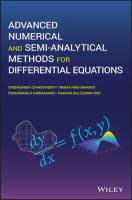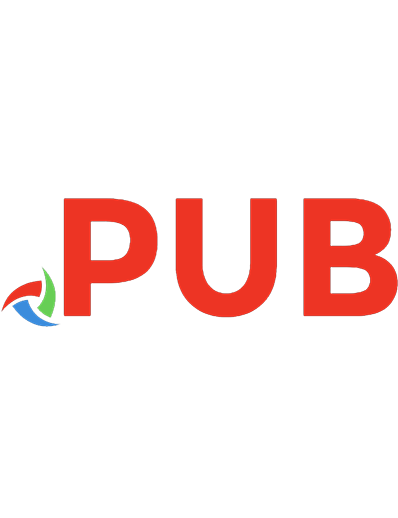Approximation Methods for Solutions of Differential and Integral Equations [Reprint 2018 ed.] 9783110944693, 9783110354751
183 18 24MB
English Pages 329 [332] Year 1995
Polecaj historie
Table of contents :
Contents
Preface
1. Introduction to approximation theory
2. A simple approach to Fredholm integral equations of the second kind and application of linear methods for approximating their solutions
3. Iteration method for approximately solving differential and integral equations
4. Approximation method for solving ordinary linear differential equations
5. Approximation of solutions of partial differential equations
6. Theory of transcendental functions and their approximation
7. Application of the α—method to the rational approximation and integral representation of functions
Bibliography
Citation preview
Approximation Methods for Solutions of Differential and Integral Equations
APPROXIMATION METHODS FOR SOLUTIONS OF DIFFERENTIAL AND INTEGRAL EQUATIONS
V.K. Dzyadyk
m MSPm
Utrecht, The Netherlands, 1995
VSP BV P.O. Box 346 3700 AH Zeist The Netherlands
© VSP BV 1995 First published in 1995 ISBN 90-6764-194-4
All rights reserved. No part of this publication may be reproduced, stored in a retrieval system, or transmitted in any form or by any means, electronic, mechanical, photocopying, recording or otherwise, without the prior permission of the copyright owner.
CIP-DATA KONINKLIJKE BIBLIOTHEEK, DEN HAAG Dzyadyk, V.K. Approximation methods for solutions of differential and integral equations / V.K. Dzyadyk. - Utrecht : VSP With ref. ISBN 90-6764-194-4 bound NUGI811 Subject headings: differential equations / integral equations
Printed in The Netherlands by Koninklijke Wöhrmann BV, Zutphen.
Contents Preface
5
1 Introduction to approximation theory 1.1
Chebyshev theory of approximation of real functions
9
1.1.1
9
1.1.2
Existence theorem Chebyshev theorem on the characterization of a polynomial of best uniform approximation
1.2
1.3
9
11
1.1.3
Uniqueness theorem
17
1.1.4
Lower estimate of the value of best approximation
17
1.1.5
Chebyshev polynomials
19
1.1.6
Chebyshev polynomials of the second kind
23
1.1.7
An efficient construction of polynomials least deviating from zero with polynomial weights
24
1.1.8
The notion of snakes
31
1.1.9
Chebyshev approximation of functions by rational polynomials
33
Linear methods of Fourier series summation and approximation of continuous functions
37
1.2.1
Linear methods of Fourier series summation
38
1.2.2
Discrete polynomial linear operators
Lagrange interpolation polynomials 1.3.1
Fundamental Lagrange polynomials of a general form. Lebesgue functions and constants
1.3.2
43 44 44
Periodic Lagrange polynomials constructed with equidistant nodes and corresponding algebraic Lagrange polynomials
1.3.3
Explicit formulas for Lebesgue constants in interpolation constructed with optimal nodes
1.3.4
53
The representation of Lebesgue constants as sums of asymptotic series
1.4
47
63
Estimating the best approximation of analytic functions on a segment by polynomials
71
2
1.5
2
1.4.1
Basic definitions
71
1.4.2
Bernstein theorem
72
Estimates for the norms of trigonometric and algebraic polynomials by their values at a discrete system of points
76
A simple approach to Fredholm integral equations of the second kind and application of linear m e t h o d s for approximating their solutions
81
2.1
Some preliminaries
81
2.2
Degenerate kernels
83
2.3
Basic theorem
86
2.4
Fredholm theorems
90
2.5
Theorems on resolvents
94
2.6
Methods for approximating the solutions of Fredholm integral equations of the second kind
3
Iteration m e t h o d for approximately solving differential and integral equations
119
3.1
Picard's method for the Cauchy problem with an analytic right hand
3.2
Al-method for approximating solutions of the Cauchy problem for
side
119
ordinary differential equations by polynomials 3.3
123
Al-method for approximating solutions of certain nonlinear integral equations by polynomials
4
97
132
A p p r o x i m a t i o n m e t h o d for solving ordinary linear differential equations
145
4.1
Auxiliary facts
4.2
Methods that result from using a sequence of linear operators to solve approximately differential equations
4.3
a-method for approximating solutions of linear differential equations
4.4
A posteriori estimates of errors for polynomial approximation of ODE
with polynomial coefficients by polynomials
4.5
148 154
solutions
171
4.4.1
Nonlinear case
171
4.4.2
Linear case
173
a-method for approximating the solution of boundary value problems for OLDEPC and its derivatives by polynomials
4.6
145
174
Comparison of the a-method with Galerkin's method, Lanczos' rmethod and the Al-method
188
Contents
5
3
Approximation of solutions of partial differential equations
193
5.1
193
5.2
Dirichlet problem for LDEPC of elliptic type in a rectangle Approximate solution of the initial problem for LDEPC of parabolic type in a semistrip
5.3
5.4
196
Application of the a - m e t h o d to LDEPC of hyperbolic type
197
5.3.1
197
The Goursat problem
5.3.2
The Cauchy problem
202
5.3.3
The mixed problem
206
The Al-method for solving nonlinear Cauchy, Darboux and Goursat problems for differential equations of hyperbolic type
6
209
Theory of transcendental functions and their approximation
225
6.1
225
6.2
Preliminaries Formulas for the coefficients of the Newton polynomials and for the derivatives of f(x)\g(x)]k
6.3
228
Investigation of Wronskian and its minors for a fundamental system of solutions of LDE with a single regular singular point
234
6.4
Investigation of the Cauchy-Green function for LDE with SRSP . . . 237
6.5
Equations for analytic parts of special functions
246
6.6
Initial conditions for analytic solutions of LDE with SRSP
253
6.7
Efficient construction of polynomials for a close to the best approximation of analytic parts of solutions of LDE with SRSP
7
255
Application of the a—method to the rational approximation and integral representation of functions 7.1
267
Application of the a - m e t h o d to the rational approximation of solutions of Cauchy problems and Pade's approximation of elementary functions
267
7.2
Construction of generalized moment representations
275
7.3
Application of generalized moment representations to Pade's approx-
7.4
Application of GMR to Pade's approximation of basic hypergeometric
imation series 7.5
286
Generalized moment representations and integral representations of functions
7.6
280
292
Rational approximation of elementary functions on an interval . . . . 295
Bibliography
313
Preface This book is the result of 20 years of investigations carried out by the author and his colleagues in order to bring closer and, to a certain extent, synthesize a number of well-known results, ideas and methods from the theory of function approximation, theory of differential and integral equations and numerical analysis. This synthesis is carried out in a direction which is distinct from the well-known directions taken by the scientific research schools of S. M. Nikol'skii-S. L. Sobolev [22, 108, 131, 148], K. I. Babenko [9], N. S. Bakhvalov [13], A. A. Gonchar ([87], [88]), P. L. Ulyanov [160] and others. This book develops and, in a number of cases, deepens various theoretical and practical aspects of the "direct methods", which were developed by Ritz, I. G. Bubnov, B. G. Galerkin, N. M. Krylov, N. N. Bogolyubov, M. F. Kravchuk, M. V. Keldysh, L. V. Kantorovich, S. G. Mikhlin, N. I. Polsky, G. M. Vainikko and others. Chapter 1 contains an introduction on the theory of function approximation. Chapter 2 deals with a new approach to the Fredholm integral equations of the second kind. This chapter is also concerned with obtaining good estimates for the approximation of the solutions of these equations. Chapters 3-5 are devoted to the construction of new methods for the effective approximation of solutions of several important integral, and ordinary and partial differential equations. Error estimates for these approximations are also considered. Chapter 6 presents some new general results on the theory of linear differential equations with one regular singular point. Based on these results, a new efficient method for approximating special functions which are solutions of these equations is developed. Chapter 7 is concerned with the application of the methods constructed in Chapter 4 and the generalized moment representations obtained from the development of these methods, questions on the Pade approximation, rational approximation of elementary functions on an interval and obtaining new integral representations for various special functions. From other books and papers on the closely related subjects, this book is distinguished by the following features. 1.
Theorem 1.1.5 strengthens the results of Chebyshev, A. A. Markov and
S. N. Bernstein on the efficient construction of polynomials T°(x) on [—1,1] which 5
6
Contents
generalizes t h e classical Chebyshev polynomials Tn(x)
in the case where there is a
positive polynomial weight on [—1,1] . In many cases this generalization allows the difference y(x) — yn(x) approximation yn(x)
between the solution y(x) of an equation and its polynomial
to be estimated by the following asymptotic equality
where _E„(j/)||.|| is t h e best approximation (with respect to the norm || • || with Chebyshev weight) of t h e solution y{x) by polynomials of degree not greater than n. 2. Theorem 2.2.2 (solvability criterion) enables us to achieve several objectives. First, we obtain an "algebraic" criterion for the solvability of any Fredholm equation of t h e second kind.
Second, any solution of the Fredholm equation with "large"
kernel can be represented as a linear combination of functions, each determined by an equation with "small" kernel. Third, we construct a resolvent, which is finite almost everywhere for any value of the parameter Ao provided t h e equation is solvable for this value. At last, with this theorem we achieve a simpler and more natural explanation on the theory of Fredholm equations of the second kind. 3. Chapter 2 presents a method for the approximation of periodic solutions y(t) of Fredholm integral equations of t h e second kind with the help of a sequence of linear operators Un. For the operators Un = Sn for taking the n t h order partial sum of Fourier series, de la Vallee Poussin operators and some others, this method allows us to obtain effectively the trigonometric polynomials y„(t) satisfying h ( t ) - y»(0llc = (i + e»)||y(0 - Un(y; 011c,
^
o.
4. In Chapter 3 and Section 5.4 we set out the approximate iterative m e t h o d for t h e approximate solution of differential and integral equations under analytic conditions.
When high accuracy is needed, this method usually provides much
better results than other methods known to the author. 5. Chapter 4 and Sections 5.1-5.3 present the approximation method ( a - m e t h o d ) for solving linear differential equations with polynomial coefficients. For the general Cauchy problem and boundary value problem for ordinary differential equations, this m e t h o d efficiently constructs the polynomials y„(x) on [—h, h] satisfying, in t h e one-dimensional case, equality (*) in t h e metric L ^ j with Chebyshev weight
p(x).
In t h e many-dimensional case, the polynomials constructed satisfy similar though less sharp equalities.
As to its form, the a - m e t h o d is similar to the well-known
Lanczos r - m e t h o d . However, the latter is a remarkable empirical numerical m e t h o d whereas t h e a - m e t h o d has a strong theoretical background. For example, we prove t h e existence theorem for t h e polynomials yn(x) and obtain suitable representations for t h e difference y(x) — yn(x).
In particular, we establish an equality similar to (*).
In our opinion, this method is more flexible.
Preface
6. Considering linear differential equations with a regular singularity in Chapter 6, we (1) investigate the behaviour of the Wronskian and its certain minors in the neighbourhood of a singular point, (2) investigate the Cauchy-Green function, (3) provide explicit constructions for the resolvents of integral equations which are equivalent to differential equations defining the analytic parts of special functions, (4) obtain differential equations for each analytic part of a given special function and apply the a-method to these equations. 7. Section 7.1 deals with the generalized moment representations for functions. These representations generalize the results by Chebyshev on the classical moment problem to much wider classes of functions. In particular, we obtain the analogues of the well-known results of Pade and van Rossum on the Pade approximation of basic hypergeometric series. We also provide a number of new integral representations for a wide class of special functions. During the last ten years, a substantial portion of the results presented in this book was presented in lectures to the students of mathematical analysis and mathematical physics at Shevchenko Kiev State University. The author wishes to note that the following persons greatly contributed to the development of certain questions considered in this book, M. Azizov, A. G. Bakan, A. M. Basov, V. I. Bilenko, V. A. Borodin, V. P. Burlachenko, Ya. F. Vasilenko, A. P. Golub, P. N. Denisenko, S. F. Karpenko, V. R. Kravchuk, V. V. Krochuk, P. D. Litvinets, Yu. I. Mel'nik, L. A. Ostrovetskii, Yu. K. Podlipenko, A. S. Prypik, Yu. I. Romanenko, V. K. Stolyarchyk, L. I. Filozof, M. N. Chyp, L. B. Shevchuk, P. S. Yanchuk and others. In trying to keep the book small in size, in most cases we omit the proofs of the existence theorems and give appropriate references to the papers where these proofs can be found. In comparison to the original papers, many results in the book have been improved.
7
Chapter 1 Introduction to approximation theory 1.1
Chebyshev theory of approximation of real functions
The problem of approximating some functions using other simpler functions, is one of the most significant problems in almost all areas of mathematics (we can cite, for example, the problem of approximating analytic functions by Taylor sums or approximating continuous functions by interpolation polynomials). Usually, it is desirable not simply to approximate a function from a certain set using a simpler function (of a narrower set), but to obtain the best approximation under certain conditions. We begin by explaining the main results in this field, which were obtained by Chebyshev in the middle of 19th century. We will then consider the later results of E. Borel and de la Vallee Poussin by applying and developing Chebyshev's results.
1.1.1
Existence theorem
Let B be a Banach space over the field R or C and let Bn be its subspace of dimension n + 1 containing elements of the form n
bn = bn(c) = ^cJb°J,
b°} e Bn.
j=o
Definition 1. For any element f £ B, the number £»(/)=
inf 9
||/-6n(c)||
(1)
10
Introduction to approximation theory
is called the value of its best approximation by elements of B„. For any / 6 B element R defined on [a, 6], This theorem was the starting point in the subsequent development of the theory of function approximation. T h e o r e m 2. Chebyshev theorem [27]. Let a continuous real-valued function f ( x ) be defined on the interval [«,&]. Then, in order for a polynomial P*(x) of degree not greater than n to be the polynomial of the best uniform approximation for f ( x ) in the class Vn of polynomials of degree not greater than n, it is necessary and sufficient that there is at least one system ofn-f 2 ordered points Xj : a < xi < x? < ... < xn+2 ^ b from the interval [a, 6] such that the difference f(x)-P:(x)d^rn(x)
(4)
(1) takes the values with alternate signs; (2) attains the maximum absolute value on [a, 6], i. e. the condition r„(:n) = ~rn(x2)
= ... = (~l)n+lrn{xn+2)
= ±||rB(i)||c.
(5)
Introduction to approximation theory
12
is fulfilled. A set of points {xj}j+2
that satisfy these equalities is called an alternation or
Chebyshev alternation. E x a m p l e . Let / ( x ) = sin x. We check that the polynomial P6*(x) = 0 is a polynomial of the best uniform approximation of degree 6 to this function on [—ATT,4TT]. Indeed, it follows from this that the difference r 6 (x) = sinx — P£(x)
= sinx
satisfies the condition of the theorem at 6 + 2 = 8 points x¡, = — ^w + kiv, k = 0 , 1 , 2 , . . . , 7 from [—4tt, 4tt] r 6 (x) = sin(fc7r - 7-*) = ( - 1 ) * = ( - l ) * | | r 6 ( x ) | | c .
P r o o f of T h e o r e m 2. Necessity.
We exclude the case where the function / ( x ) is
itself a polynomial of degree not greater than n since it is self evidently true. Before proceeding with the proof we provide a definition. Each point xo € [a, 6] that satisfies the equality |r„(x 0 )| = IM^OIIcm]
r n ( x 0 ) = ±||r n (x)|| c [ ( l i t ]
(6)
is called a point of maximum deviation for the difference / ( x ) — P*(x) = r n ( x ) or e-point (i.e., extremal point). Moreover, if the condition rn(x o) = | | r n ( x ) | | c
(7)
is satisfied at the point xo, then this e-point is called a point of positive deviation or (+)-point, and if r n {xo) = - max |r„(x)|,
(8)
a

![Weighted Polynomial Approximation and Numerical Methods for Integral Equations [1 ed.]
9783030774967, 9783030774974](https://dokumen.pub/img/200x200/weighted-polynomial-approximation-and-numerical-methods-for-integral-equations-1nbsped-9783030774967-9783030774974.jpg)

![Singular Integral Equations’ Methods for the Analysis of Microwave Structures [Reprint 2018 ed.]
9783110941968, 9783110460391](https://dokumen.pub/img/200x200/singular-integral-equations-methods-for-the-analysis-of-microwave-structures-reprint-2018nbsped-9783110941968-9783110460391.jpg)






![Approximation Methods for Solutions of Differential and Integral Equations [Reprint 2018 ed.]
9783110944693, 9783110354751](https://dokumen.pub/img/200x200/approximation-methods-for-solutions-of-differential-and-integral-equations-reprint-2018nbsped-9783110944693-9783110354751.jpg)